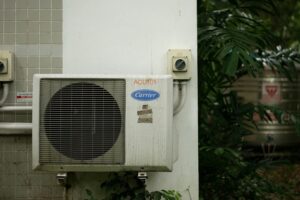Once the summer months arrive, so does the heat—and there’s nothing worse than a hot home in an even hotter season. If you’re noticing that your home is working overtime to stay cool during the warmer months or year-round, there may be some problems you need to solve.
Recognizing issues with your air conditioning or other cooling method is imperative to staying cool once the high temperatures arrive. Here are 6 mistakes you may be making that are contributing to your home feeling too hot and how to fix them, according to a professional.
1) Your Current AC Unit is Old
Has your AC unit seen better days? An old air conditioning unit may be the culprit for your home seeing higher temperatures.
“Old air conditioning units are the number one reason for higher temperatures,” Stack says. He recommends replacing your unit every 12 to 15 years to keep it in pristine condition and working properly.
If you’re having trouble determining whether your current system is on its last leg, Stack says there are a few tell-tale signs that your unit needs replacing.
“Constant run time is another big indicator that it’s time to replace your unit,” he says. “If your unit is constantly running and never satisfying the home or the humidity stays in the house, it’s time to replace.”
:max_bytes(150000):strip_icc():format(webp)/GettyImages-1426586489-30a3ea0e8323491390c707628cf5196b.jpg)
2) Improper Home & Attic Insulation
Proper home and attic insulation is important for keeping home temperatures consistent and comfortable year home. A home and attic that has been improperly insulated could be why you’re expiring hotter temperatures. If your home is not insulated correctly, this can cause extended run times of your AC unit and higher levels of humidity.
There are several ways to tell if improper insulation is causing higher temperatures, but Stack tells us the easiest way is during the winter months. A poorly insulated attic in the winter won’t have any frost or snow on it, as heat ill rising through the home and out of the attic.
“If the home isn’t properly insulated, you’ll also be able to feel the heat from outside through the wall—there’s a big difference between from the interior and exterior wall temperature.” he says.
Tip
If you suspect your home may be poorly insulated, it’s highly recommended to let a professional check your home for any issues that can be fixed, pronto.
:max_bytes(150000):strip_icc():format(webp)/GettyImages-182186960-d6c9a119f53e4809a868662b7be8d085.jpg)
3) Your Windows and Doors Aren’t Sealed
Stack says your home may be experiencing hotter temperatures if windows and doors aren’t sealed properly. These gaps allow in warmer air that creates drafts, causes your unit to work harder in cooling the home, and thus, creates higher levels of humidity.
There’s an easy way to fix this problem that can be done DIY-style. Seal gaps in windows and doors with expandable spray foam or foam insulation tape that most local hardware stores sell, says Stack. So, if you’re feeling hotter temperatures indoors or more humidity, take a gander at your doors and windows for any gaps that may need to be sealed.
:max_bytes(150000):strip_icc():format(webp)/GettyImages-1461193088-f3b9a939076d4b99ab938019ef332864.jpg)
4) Improper Ductwork
Ductwork is responsible for transmitting the cooler air from your outdoor unit throughout your home. If your home has little to no cool air, things may be wrong with your ductwork. Improperly installed ductwork can lead to ducts not being sealed correctly, which causes the cool air to leak out into the openings.
Curious if this is your problem? Stacks says improper ductwork can show in many ways.
“No air in rooms at all, reduced airflow in the rooms, or if the ductwork is banging when it turns off and on is a sign that something isn’t right,” he says. “Also, if the duct is blowing its insulation out of the vents, it would be recommended to replace the ductwork.”
:max_bytes(150000):strip_icc():format(webp)/GettyImages-184884750-61aa98a68342448fa22cc9fd43475260.jpg)
5) Skipping Yearly Maintenance Checks
Maintaining your air conditioning unit is crucial to provide comfortable temperatures in the home and to ensure the longevity of your system. While it may be the rule of thumb to replace units every 12 to 15 years, Stack gave us practical advice on preserving your unit so that you might be able to squeeze longer time out of your system.
“It’s recommended to have a professional come and check your home twice a year,” Stack says. “One in early spring and then again in the fall, that way you’re prepared for the hot and cold months.”
Aside from the two yearly maintenance checks, Stack says that there are things you can do at home to further protect the performance of your unit. “Make sure you keep your indoor filter changed routinely and that your outside unit stays clean and free of dirt or debris.”
:max_bytes(150000):strip_icc():format(webp)/GettyImages-1227299278-bb5ce6627ff143d2beca718f0d85c917.jpg)
6) Not Switching Out Indoor Filters
Indoor filters are responsible for circulating the air and catching pollen, dust, allergens, and other particles to provide cleaner air. While Stack recommends switching out these filters every 1 to 3 months, he notes that some indoor activity may cause you to switch these filters out sooner.
Take a look at the current indoor filter in your home and note if it’s dusty around the edges or if it appears to be clogged. If it looks clogged (or you can’t remember the last time you changed it), it’s time for a new filter.
Text taken from: https://www.thespruce.com






